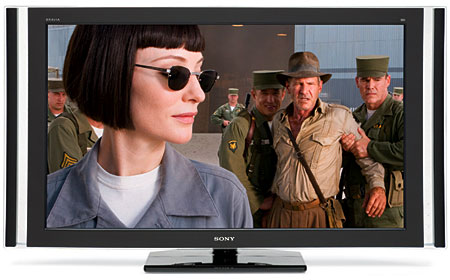Sony KDL-55XBR8 LCD TV

However, Samsung was not the first to bring an LED-backlit LCD TV to market. That honor goes to Sony way back in 2004 with the Qualia 005, which was clearly ahead of its time. At $15,000 for a 46-inch screen, it was also way ahead of most buyers' budgets. So was the 70-inch KDL-70XBR3 in 2007, which also used LED backlighting and listed for a whopping $32,000.
Sony's latest entry into the LED fray is the XBR8 line, which includes a 46-incher and the 55-inch KDL-55XBR8 reviewed here, both of which are much less than the company's previous offerings, though they ain't cheap by any means. I'm very excited by the potential of LED backlighting, so let's see how well the current Sony lives up to that potential.
Features
Of course, the most distinguishing feature of the 55XBR8 is its LED backlight with local dimming. Most LCD TVs use fluorescent lamps for a backlight, which usually results in a fairly high black level. The backlight in some LCD TVs can be made to dim or brighten automatically as the brightness of the image changes, reducing the black level and increasing the perceived contrast, but this can also cause visible "brightness pumping" because the brightness of the entire screen changes uniformly.
By contrast, the 55XBR8's backlight is an array of red, green, and blue LEDs—an arrangement Sony calls Triluminous—which can be dimmed or brightened in small groups according to the brightness of the image in different areas of the screen. For example, in a night scene with a bright object, the LEDs behind the object can be brightened while the LEDs behind the dark areas can be dimmed. This results in much lower black levels and much greater contrast than conventionally backlit LCD TVs can manage.
There are two potential problems with LED local dimming—haloing and black-level pumping. Because there are far fewer LEDs than LCD pixels (thousands versus millions), light from the LEDs behind bright objects can leak into adjacent areas of darkness, causing halos around the bright objects. Also, as the LEDs change brightness in different parts of the screen, the black level can appear to rise and fall, which is similar to brightness pumping in conventional dynamic backlights.
Sharp's Limited Edition LCD TVs also use red, green, and blue LEDs, but Samsung's A950 series uses white LEDs with red, green, and blue filters for each pixel. Is one approach better than the other? Samsung claims that white LEDs are more energy-efficient, while Sony says that RGB LEDs deliver purer color.
As with virtually all high-end LCD TVs these days, the 55XBR8 doubles the rate at which complete frames are flashed on the screen, from 60 to 120 per second. This is supposed to reduce motion blur, a problem endemic to LCD TVs. If it receives a 60Hz signal (such as 480i/p, 1080i, or 1080p/60), it inserts an extra frame between the actual frames in the signal; if it receives a 24Hz signal (that is, 1080p/24), it inserts four new frames between the actual frames to reach 120Hz.
A feature called Motionflow interpolates between actual frames to create these extra frames, calculating where objects in motion should be in each new frame. This is intended to smooth out onscreen motion. If Motionflow is turned off, the set simply repeats each frame two or five times, depending on the rate of the source signal.
Another interesting feature common to many Sony TVs is the DMex (Digital Media Extender) USB expansion port on the back panel, which lets you connect proprietary DMex modules that add new functionality to the set. Four modules are currently available: Bravia Input Link ($150) adds four HDMI inputs, Bravia DVD Link ($200) provides a DVD player, Bravia Wireless Link ($800) offers a wireless HDMI connection, and Bravia Internet Video Link ($300) connects to your home-network router and streams online content directly to the TV from partner providers such as YouTube, Amazon On Demand, CBS, AOL, Yahoo, and Sports Illustrated among others.
A second USB port on the side lets you connect a storage device with JPG photos and MP3 music files. You can also access photos on any networked DLNA (Digital Living Network Alliance) server by connecting the TV's Ethernet port to your router. Sharing photos like this is way better than crowding around a computer screen, and you can play music during the slide show, but why anyone would otherwise want to listen to music on any TV's internal sound system is beyond me.
Like most modern TVs, the 55XBR8 implements HDMI 1.3, which allows the use of the Consumer Electronics Control (CEC) protocol to control other HDMI 1.3 devices connected to the set. Sony calls its implementation of CEC Bravia Theater Sync.
The 55XBR8 offers a number of video-processing "enhancements," such as Black Corrector, Clear White, Live Color, and Advanced Contrast Enhancer. However, I normally find that these degrade the picture rather than improve it, so I leave them turned off. However, I found that the DRC (Digital Reality Creation) processor did improve the set's deinterlacing and scaling, at least when set to Mode 1.
Also available is TV Guide On Screen, an electronic program guide for broadcast TV channels. This is a nice touch, though probably superfluous for most users who have cable or satellite service with their own EPGs.




























































